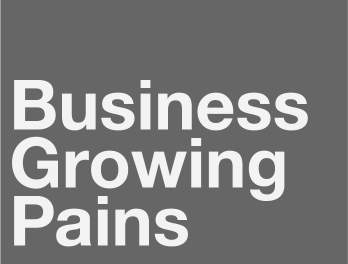
Dr Peter Ellis
RELIEVING BUSINESS GROWING PAINS
Have you ever felt that if you had a better understanding of the books that you would be able to strategically grow and cut waste at the same time? It is a fact that the vast majority of accounts are not set out in a way that an owner can use for the benefit of the business. That is why accounts are left to bookkeepers and accountants, but that should not be the case. Accounts are very important, but not nearly as important as accountants make them out to be, and if set out correctly can easily be comprehended and used for the benefit of their business by the owner..
I have had a client wishing to sell their business. With a standard P&L and Balance Sheet, the potential buyer offered a very low sum. When the P&L was reconfigured into Gross Profit, Operating Profit and Net Profit, with the income and Nett being the same. The clear value of the company increased over 700% to the same buyer overnight!!
Accounts that are well organised, are not that difficult to understand and give information to know how the business is doing and what decisions can be taken. Accounts can be understood by anyone even if you do not understand maths. As the numbers are only there in order to make business decisions, and once understood, are not difficult to use.
Who will this information help?

The Theory
What does a small enterprise need from the accounts?
- A small company needs to know how to gauge if they are spending too much or could spend more in some areas and when they are able to buy assets for the company
- The reason that the P&L has different sections, is for the management to be able to make decisions. The breakdown is not for the Tax Office. The accountant uses the separate sections as a means of balancing where savings on tax may be made, but that does not help the day to day running of the business.
A situation found in small businesses.
A company with whom I was put in touch, had been working in the city for many years and had built a good client base with a well established reputation as honest and reliable. When the time came to retire, the only people willing to buy the company, saw a loss on the bottom line and therefore made an offer below half of what was being asked. I was asked to see if I could make the company appear more valuable in some way.
At first glance, the sales and lack of profit did not look encouraging, however I was able to see a number of things that could change the way in which the firm was being viewed.
As the firm had been in business to provide and keep up the appearance of plants in the city, I found that the value of the products that would have to be replaced if the firm closed and a new firm had to replace the stock was more than the original asking price. Secondly, the manner in which the accounts were set out gave no indication of how the firm was financially tracking.
The accounts showed sales, expenses and a net loss. In order to improve the situation, I rearranged the layout of the accounts, without changing the total sales or net loss. First I broke down the income into operating income and non-business income which showed what activities were bringing in income. I then moved the items that related to the cost of the goods sold and the balance gave a gross profit which I explained how that should be viewed. I then collected the operating expenses in groups to show that the enterprise was providing a substantial operating profit. Finally, I collected those incomes and expenses that were not a part of the business operation and showed that the owner was buying assets with the operating profit.
Although the net amount was a loss, it was clear that the business was making a profit and that it would cost a lot to replace the assets being used at the client’s premises. The result was that the next day, the same potential purchasers of the business offered seven times their original offer.
What does the medium-sized enterprise need from the accounts?
A medium-sized enterprise must know the different elements of their income and therefore how to plan future sales.
- The cost of sales may be different for product ranges, or sales areas and needs to be made clear.Where clients have expenses set out alphabetically or generally without being grouped, it is difficult to know which more profitable areas of the firm are needing more financial aid and where spending is too generous.
- The expenses of each department need to be clear to ensure that the cost structure relates to each department.
Situations found by medium enterprises
Telling staff what management think would be useful, when they do not know why, or the reason for the instructions, usually leads to inconsistent results.
Without knowing how the income or expenses are affecting the profitability of the enterprise results is decisions being no more than guesswork.
Once the simple changes are made the management and account sections now what is happening. Know when and how much may be spent and know how to make each department as profitable as possible.
Business Growing Pains (BGP) specialises in clarifying the activities necessary for enterprises to develop and have sustained management activities. A client that had been in business for over twenty years had been built from the ground up by one person. They understood how everything was built, how it fitted together and what the clients wanted. They controlled every element of the business that was semi departmentalised but needed the owner’s approval to act.
I was called in when the general manager (GM) was looking to take over the reins of the firm, as the owner found it difficult to continue managing every aspect of the enterprise as he had done from the time it was established. The problem was that the GM was not familiar with the technical side of the business and had a corporate background. Therefore the owner was trying to move away from the cutting edge and the GM only wanted to come in, sit in the office and give vague instructions. The result was that the company was stuck in limbo as neither knew how to manage the larger enterprise or was able to learn.
This situation is more common than is realised and in fact over half of private sector enterprises that are growing or want to grow, are stuck in this limbo. YSP specialises in resolving this issue!

Breaking down the steps.
Below is an overview of what you will need to do in order to understand, organize and take control of your business finances
- To understand what is required.
- Understand how to read a simplified set of accounts shown to you by YSP
- To organise the accounts,
- Be shown by YSP how to organise and manage accounts in such a simple way that the business position is understood and decisions become clear
- What is a simple way to know the breakeven point as the business grows.
- Accept that YSP can show you more than just how to get more sales, but also how to understand how to think like a business owner
- How to make sure that the gross profit stays constant.
- BGP can show you how to know what you need to do to not only understand but when to act.
- How to know that costs are under control? To know that your costs are under control, there are three things that must be happening
- Your gross profit must be a constant percentage of your income. If it continuously changes, then there has to be a reason. Either the costs keep changing, or you have the wrong data included that is not a constant in terms of percentages. Once you know that percentage, you can keep an eye on it to ensure the sales charge is in line with any change in spending.
- Your expenses should remain constant. If they change, you must know why. For example an increase in staff or higher rent or end of year spending on accounting.
- Knowing the simple equation to identify your breakeven target should be checked regularly to ensure that you are making an operating profit.
- Finally, not spending more than the operating profit on assets or other expenses.
Recap
What does this mean for you and your business?
The key to success is forward planning. This may be done with a simple one-page planner once a week, month and year, to check and therefore know, where you want to go and if you are going there.
Remember, no matter how big or small your business, without a plan, you will be worried and stressed not knowing how you are doing.
Your Commitments to the Business and the Tax Department explained.
One of my clients was in the construction industry. They had plenty of work but never seemed to have enough money to build the next property. Each property was sold in advance by a canny commission agent, yet at the end of the year, funds were sparse.
I used the figures for each property and discovered that while the agent was always getting their commission percentage, to make the sale, the property was sometimes sold with little or no profit and sometimes at a loss. In fact, I found that half the properties sold were below the cost price. The agent did not care as they always had to have the commission, but the builder did not check the costings and that was the reason they were not making the necessary percentage gross profit. The method of ensuring a profit was made and the agent still received a good commission was simple.
Another client was three years behind with their tax payments because they were not able to pay the full amount in one payment. Once an agreement was made with the Tax Office, a regular payment was agreed and the debt was repaid over an agreed time frame. The Tax Office wants the money, it is not in their interest for you to close down.
Points to consider
1. What does the Tax Department require from your accounts?
- Total sales
- How much tax received
- Total expenses
- How much tax spent
- Revenue from wages
- Balance of tax owed to the Department
- Percentage of tax from any net profits – Sales less expenses.
You will see that the Tax Department does not care about your sales breakdown unless that affects the tax.
It does not care about the breakdown of any legally allowed expenses, except those relating to taxes, wages or non-taxable items.
2. What does this mean
This shows, that the reason you have a chart of accounts is not directly for the Tax Office. If you look at the tax form, it only asks the income and what is taxable.
The chart of accounts if for you to set out to enable you to see it and in less than five minutes be able to make all your financial business decisions. If you are unable to, it is not your fault, it is because whoever set up the chart of accounts did not pre[pare it in a way that you could understand it. BGP specialises in showing you how to do that.
3. Overall benefits of changing the P&L and Balance Sheet Structure
Each sized enterprise requires different management activities and structures. In order for the owner-manager to have a stable or growing enterprise, depends on how they manage the business. By having a simple financial structure, decisions are easier to make and offer a better return and result.
All businesses, no matter their size, require the chart of accounts to give the owner the information that enables then to be aware of their solvency. The problem is that 95% of businesses have their information set out in a matter to confuse them rather than aid them.
BGP training goes straight to the heart of the matter and shows how to take that pain away.
In Summary
The BGP system was set up as a result of the World Bank, European Union and Reserve Bank of Australia’s demand for a more understandable definition of business sizes. Dr Ellis found that micro, small and medium comparisons by industry and location was not useful as a means of defining business sizes.
Using the results of studies carried out by the top experts in business research, he found that each expert focussed on one area of business. Those being the abilities of the owner and the business organisation. Dr Ellis combined them into a simple matrix to be able to, not only redefine each size but show that there were two very important stages between each size that required understanding. In fact, he suggests that not understanding the interim stages was probably the main reason for business failure.

Related Articles
TOP 10 CAUSES OF BUSINESS GROWING PAINS
TOP 10 CAUSES OF BUSINESS GROWING PAINS 1. Lack of Product Market Fit - Product market fit is the relationship between your products and services and your market. It is the gauge the venture capitalists look at a prospective investment to see whether it has identified...
What is Product Market Fit & Why is it so Important?
creating a business strategy for your online business or bricks & mortar business should be similar evaluate plan and engage with experts. They can point out the holes in your strategy allowing you the room to develop it further.
Habit Creation For Business Success
Relying on motivation and passion to build your business is exhausting and unreliable. Building habits around your tasks and work output will ensure you complete what you set out to achieve.
Follow Us
Subscribe For Updates & Offers
Lorem ipsum dolor sit amet, consectetur adipiscing elit. Aenean scelerisque suscipit condimentum. Vestibulum in scelerisque eros. Fusce sed massa vel sem commodo.



Loving the info on this website , you have done outstanding job on the blog posts. Babb Rodney Herrmann
Excellent post! We will be linking to this particularly great article on our site. Keep up the good writing. Dacy Meredith Dragone
Hiya, I am really glad I have found this information. Nowadays bloggers publish just about gossip and internet stuff and this is really irritating. A good web site with exciting content, this is what I need. Thank you for making this site, and I will be visiting again. Do you do newsletters by email? Greta Guglielmo Ursi
I am regular visitor, how are you everybody? This paragraph posted at this web page is really fastidious. Marina Lombard Sofia
Nice articles! Favorite add and blog love.
I appreciate how balanced and nuanced your perspective is on business growth and business growing pains. It can be hard to find writers who take the time to explore all sides of an issue. Your post gave me a lot to think about and inspired me to do some more research on my own.
Thanks UC.
I appreciate your comments. Let me know what you liked about it and if there are any other Business Growth subjects that you would like me to write about?
I learned a lot from this article, thank you for putting together such an informative piece.
So often in business, I am challenged seeing my way forward and what to improve in the business.
Thank you.
Thanks Doc.
I appreciate your comments. Let me know what you liked about it and if there are any other Business Growth subjects that you would like me to write about?
I’ve read a few good articles here. Definitely value bookmarking for revisiting.
Thanks Manuel.
I should have a few new gems coming out shortly.
Let me know what you liked about it and if there are any other Business Growth subjects that you would like me to write about?
Amazing Good Content, bravo.
Val
Cheers Val.
Let me know what you liked about it and if there are any other Business Growth subjects that you would like me to write about?
This info is worth everyone’s attention. When can I find out more?
Hey Leonard.
Thank you keep browsing the other business growth articles. I am sure you will find something.
Let me know what you liked about it and if there are any other Business Growth subjects that you would like me to write about?
Thanks a lot for that extremely cool post.
Thanks JonZ
I appreciate your comments. Let me know what you liked about it and if there are any other Business Growth subjects that you would like me to write about?
I was curious if you ever considered changing the
structure of your blog? Its very well written; I love
what youve got to say. But maybe you could a little more in the way
of content so people could connect with it better. Youve
got an awful lot of text for only having 1 or two pictures.
Maybe you could space it out better?
Simply wish to say your article is as astonishing.
The clearness in your submit is simply nice and that i can assume
you’re an expert on this subject. Well with your
permission allow me to take hold of your RSS feed to keep up to date with forthcoming post.
Thank you a million and please keep up the gratifying work.
I really appreciate the research you put into this post. Thanks for going the extra mile.
nice content thanks
Nice post admin, keep it!
I really like the site you made. also your article is very well done and really informative. thank you for everything. Sam